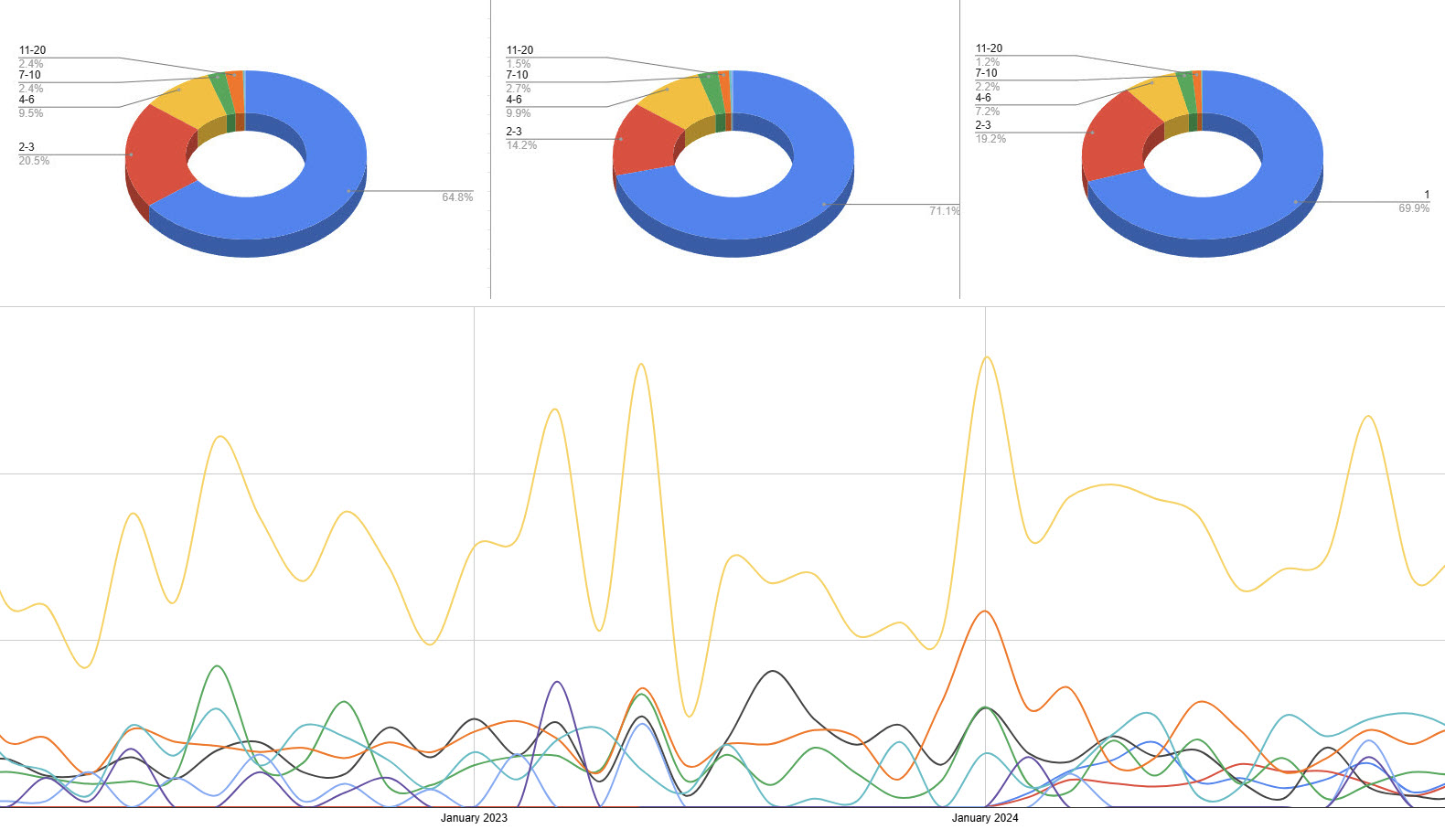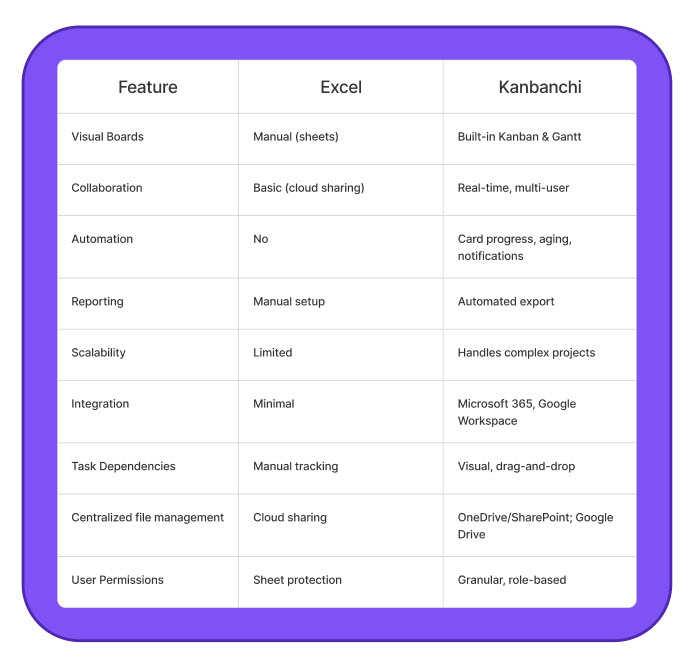
Excel Project Management: Complete Guide and Better Alternatives in 2025
Managing projects efficiently is crucial for any organization. The tools you choose can make or break your workflow. For years, Microsoft Excel has been the go-to solution for project management professionals and teams looking for a flexible, cost-effective way to organize tasks, track progress, and manage resources. However, as projects become more complex, many teams outgrow Excel’s capabilities and search for more powerful, collaborative alternatives.
In this comprehensive guide, we’ll walk you through how to manage projects in Excel – from basic task lists to advanced Gantt charts. You’ll find practical examples, step-by-step instructions, and downloadable templates to get you started. We’ll also explore the limitations of Excel for project management and introduce Kanbanchi – a modern project management app that integrates seamlessly with both Microsoft 365 and Google Workspace.
By the end, you’ll know precisely when Excel is enough, when to upgrade, and how to transition.
What is Excel Project Management?
Excel project management refers to using Microsoft Excel spreadsheets to plan, execute, and monitor projects. This approach leverages Excel’s familiar interface, powerful calculation features, and customizable layouts to help teams organize their work without investing in dedicated project management software.
Who Uses Excel for Project Management?
- Small businesses and startups seeking low-cost tools
- Project managers handling straightforward or one-off projects
- Nonprofits and educational institutions with limited software budgets
- Teams already embedded in Microsoft 365
- Freelancers and consultants managing multiple clients
- Organizations in industries such as construction, marketing, IT, and research
Typical Use Cases
- Creating project timelines and schedules
- Assigning tasks and tracking completion
- Managing budgets and resources
- Visualizing progress with charts and dashboards
- Reporting to stakeholders
Why Excel?
- Familiarity: Most professionals already know how to use Excel.
- Flexibility: Spreadsheets can be customized for any workflow.
- Accessibility: Included in most Microsoft 365 subscriptions.
- Data Analysis: Built-in formulas and charts make reporting easy.
How to Manage Projects in Excel: Step-by-Step Guide
Managing projects in Excel can be as straightforward or sophisticated as you need. Here’s a detailed, step-by-step guide to get you started, with practical examples and expert tips.
1. Setting Up Your Project Spreadsheet

Start by creating a new workbook. A well-structured project spreadsheet should include the following columns:
- Task ID: Unique identifier for each task
- Task Name: Description of the task
- Assigned To: Responsible team member
- Start Date: When the task begins
- End Date: When the task is due
- Duration: Calculated as =End Date – Start Date
- Status: Not Started, In Progress, Completed, Blocked
- Priority: High, Medium, Low
- Dependencies: Tasks that must be completed first
- Budgeted Hours/Cost: Planned resource or financial allocation
- Actual Hours/Cost: Real resource or financial usage
- Notes: Additional comments or links
Tips:
- Use Excel’s Data Validation to create drop-downs for Status and Priority.
- Freeze the header row for smoother navigation.
- Use Conditional Formatting to highlight overdue tasks or critical items.
2. Creating Task Lists and Timelines
A well-organized task list is the backbone of any project plan. To create a timeline:
- List all project tasks in the order they should be completed.
- Assign realistic start and end dates.
- Use formulas to calculate durations and flag overdue items.
- Add dependencies to clarify task order.
Sample Timeline Formula:
- Duration: =IF(AND(Start Date<>””, End Date<>””), End Date-Start Date, “”)
- Overdue Flag: =IF(AND(Status<>”Completed”, End Date<TODAY()), “Overdue”, “”)
Pro Tip: Use Excel’s Filter and Sort features to quickly view tasks by status, priority, or assignee.
3. Using Excel Formulas for Project Tracking
Excel’s real power lies in its formulas. Here are some essential project management formulas:
- % Complete: =COUNTIF(Status Range, “Completed”)/COUNTA(Status Range)
- Total Budgeted Hours: =SUM(Budgeted Hours Range)
- Variance (Budget vs. Actual): =SUM(Actual Hours Range) – SUM(Budgeted Hours Range)
- Tasks Remaining: =COUNTIF(Status Range, “<>Completed”)
Example: =COUNTIF(F2:F100, “Completed”)/COUNTA(F2:F100) This formula calculates the percentage of completed tasks.
4. Building Project Dashboards

Dashboards provide a high-level overview of your project’s health. In Excel, you can create dashboards using:
- PivotTables: Summarize data by status, assignee, or priority.
- Charts: Visualize task completion, budget usage, or schedule adherence.
- Slicers: Add interactive filters to your dashboard.
Dashboard Elements:
- Pie chart of task status
- Bar chart of hours per team member
- Line chart of the budget over time
- KPI summary (tasks completed, overdue, at risk)
How to Build:
- Select your data and insert a PivotTable.
- Add fields for Status, Assigned To, and Budget.
- Insert charts based on PivotTable summaries.
- Use Slicers to filter by project phase or team.
5. Managing Resources and Budgets
Resource and budget management are critical for project success. In Excel:

- Track each team member’s workload using a resource allocation table.
- Monitor planned vs. actual hours to identify bottlenecks.
- Use SUMIF or SUMIFS to aggregate hours or costs by person, task, or phase.
Visualize resource allocation with stacked bar charts.
6. Customizing and Formatting
- Color Code tasks by status or priority for quick scanning.
- Freeze Panes to keep headers visible.
- Group Rows/Columns for phases or milestones.
- Protect Sheets to prevent accidental changes.
Save your spreadsheet as a template for future projects, ensuring consistency and saving time on setup.
Creating Excel Gantt Charts for Project Management
A Gantt chart is a powerful visual tool for tracking project timelines and dependencies. Here’s how to create one in Excel:
Step-by-Step Gantt Chart Tutorial
- List Tasks: In your spreadsheet, create columns (e.g. Task Name, Start Date, and Duration).
- Draw Gantt charts using cells.

Customize: Use different colors for phases or teams.
Pros of Excel Gantt Charts:
- Easy to set up for small projects
- Fully customizable
- No extra software needed
Cons:
- Manual updates required for schedule changes
- Difficult to manage dependencies for large projects
- No real-time collaboration or notifications
Excel Project Management Templates
Templates can save hours of setup time and ensure best practices. Here are some of the most useful Excel project management templates:
- Gantt Chart Template: Pre-built timeline with task bars and milestones
- Project Task Tracker: List tasks, assign owners, track status, and deadlines
- RACI Matrix: Clarifies roles and responsibilities for each task
- Issue Tracker: Log, assign, and resolve project issues
- Stakeholder Map: Identify and categorize stakeholders
- Risk Register: Track project risks, likelihood, and mitigation plans
- Lessons Learned Log: Document project insights for future improvement
- Project Decision Matrix: Evaluate and compare project options
Where to Find Templates:
- Microsoft Office Templates Gallery
- Kanbanchi Blog Resources
- Project management community forums
How to Customize:
- Add or remove columns as needed
- Apply your organization’s branding
- Save as a new template for future use
Advantages and Limitations of Excel Project Management
Advantages
- Familiar Interface:
Most professionals are comfortable with Excel, reducing the learning curve.
- Cost-Effective:
Included in Microsoft 365 subscriptions, making it accessible for most organizations.
- Customizable:
Spreadsheets can be tailored to fit any workflow, from simple to complex.
- Data Analysis:
Built-in formulas, charts, and PivotTables enable robust reporting.
- Offline Access:
Work on projects without needing an internet connection.
- Integration with Office Suite:
Easily link to Word, PowerPoint, and Outlook.
Limitations
- Manual Updates:
No built-in automation; all changes must be made by hand.
- Limited Collaboration:
Real-time editing is basic; version control can be problematic, especially when multiple contributors are involved.
- No Real-Time Sync:
Changes aren’t instantly visible to all users unless they are using cloud storage, such as OneDrive.
- Scalability Issues:
Managing large or complex projects becomes unwieldy as spreadsheets become increasingly complex.
- Reporting Constraints:
Advanced reporting requires significant manual setup and maintenance.
- Lack of Integration:
Difficult to connect with other business tools or automate workflows.
- Error-Prone:
Manual data entry increases the risk of mistakes, which can have serious project consequences.
Excel vs. Professional Project Management Tools
As your projects and teams grow, you may find Excel’s limitations outweigh its benefits. Here’s how Excel stacks up against dedicated project management tools like Kanbanchi:

When Excel Works Best
- Small, simple projects
- Solo professionals or small teams
- Projects with minimal collaboration needs
- Tight budgets
When to Consider Another Project Management App
- Growing teams or organizations
- Projects with complex dependencies or multiple phases
- Need for automation, notifications, or advanced reporting
- Desire for seamless integration with Microsoft 365, Google Workspace, or other business tools
Kanbanchi: The Better Alternative to Excel Project Management

Kanbanchi is a modern, visual project management app designed for teams that need more power, flexibility, and collaboration than Excel can offer. Here’s why Kanbanchi is the ideal upgrade for Excel users:
What is Kanbanchi?
Kanbanchi is a web-based project management solution that offers:
- Kanban Boards: Visualize tasks and workflows in columns (To Do, In Progress, Done)
- Gantt Charts: Plan timelines, dependencies, and milestones
- Time Tracking: Monitor hours spent on tasks and projects
- Automation: Set up reminders, notifications, and recurring tasks
- Real-Time Collaboration: Multiple users can update boards simultaneously
- Seamless Integration: Works within both Microsoft 365 and Google Workspace environments
Key Benefits of Kanbanchi Over Excel
- Visual Management: Drag-and-drop tasks, customize boards, and see project status at a glance.
- Collaboration: Real-time updates, comments, and file attachments keep everyone on the same page.
- Automation: Reduce manual work with built-in notifications and recurring tasks.
- Advanced Reporting: Automated dashboards and charts for instant insights.
- Integration: Connect with Microsoft 365, Google Workspace, and other tools for a unified workflow.
- Export Capabilities: Easily export boards to Excel or Google Sheets for sharing or backup.
Microsoft 365 Integration with Kanbanchi
Kanbanchi is compatible with Microsoft 365, offering:
- Single Sign-On: Use your Microsoft account to log in.
- OneDrive/SharePoint Integration: Attach and share files directly from OneDrive/SharePoint.
- Excel Export: Export project data to Excel for reporting or archiving.
- Outlook: Create Kanbanchi cards from emails in your inbox.
Google Workspace Compatibility
Kanbanchi is also deeply integrated with Google Workspace:
- Google Drive Attachments: Link files and folders to tasks.
- Google Calendar Sync: Schedule tasks and deadlines with calendar events.
- Google Sheets Export: Export boards for custom reporting or analysis.
- Gmail add-on: Convert any email into Kanbanchi cards in one click.
- Marketplace App: Install Kanbanchi directly from the Google Workspace Marketplace.
From Excel to Kanbanchi: Migration Guide
Transitioning from Excel to Kanbanchi is straightforward, ensuring your team doesn’t lose valuable data or momentum.
Step 1: Export Your Excel Data
- Save your project spreadsheet as a CSV or XLSX file.
Step 2: Import or Copy Data into Kanbanchi
- Use Kanbanchi’s import feature or manually copy tasks into your new board.
- Set up columns (e.g., Backlog, In Progress, Done) to match your workflow.
Step 3: Assign Tasks and Set Deadlines
- Add team members to your Kanbanchi board.
- Assign tasks, set priorities, and add due dates.
Step 4: Customize Your Boards
- Add labels, checklists, and attachments.
- Set up automations for recurring tasks or reminders.
Step 5: Train Your Team
- Share Kanbanchi’s help documentation and video tutorials.
- Hold a kickoff meeting to walk through the new system and review its features.
Step 6: Leverage Export Features
- Export Kanbanchi boards to Excel or Google Sheets as needed for reporting or sharing.
Moving Beyond Excel for Project Management
Excel remains a powerful and flexible tool for basic project management, especially for small teams and straightforward projects. However, as your needs grow, Excel’s manual processes, collaboration limitations, and lack of automation can hinder your progress. That’s where Kanbanchi comes in.
With Kanbanchi, you get visual boards, real-time collaboration, automation, and deep integration with both Microsoft 365 and Google Workspace. Migrating from Excel is simple, and your team will quickly reap the benefits of increased efficiency, transparency, and scalability.
Transform your project management from static spreadsheets to dynamic, visual boards. Sign up for a free trial of Kanbanchi and discover how it seamlessly integrates with your preferred Microsoft 365 and Google Workspace tools.
